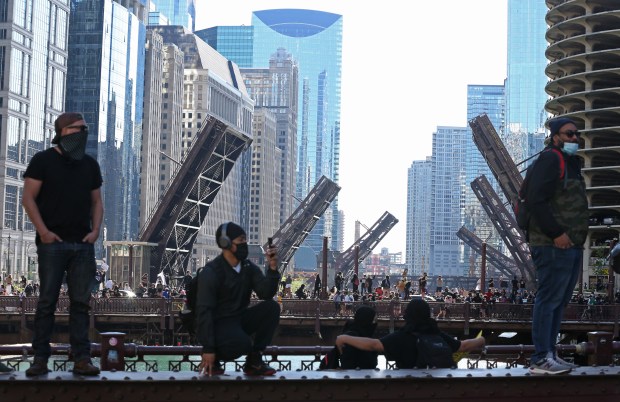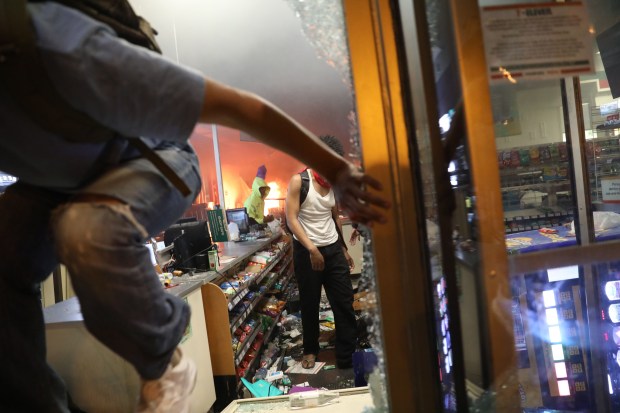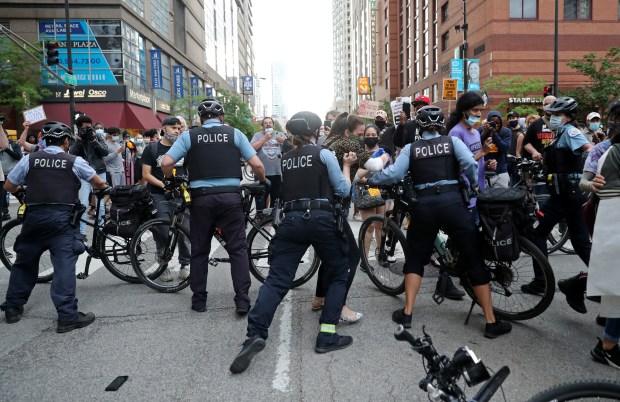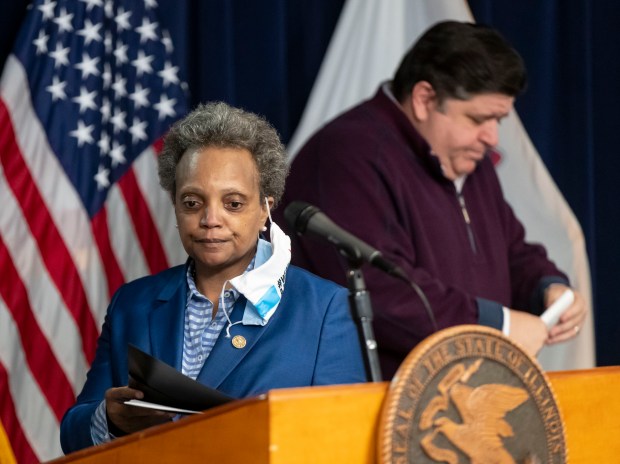The following lightly edited excerpt is from Tribune reporter Gregory Royal Pratt’s new book, “The City is Up for Grabs: How Chicago Mayor Lori Lightfoot Led and Lost a City in Crisis,” which the Chicago Review Press will publish on April 2. In the book, Pratt recounts and assesses the complex legacy of a controversial mayor who led the city through the COVID-19 health crisis. Pratt covered Chicago’s City Hall for more than five years. He currently is an investigative reporter at the Tribune.
George Floyd’s murder by Minneapolis police officers on May 25, 2020, angered the world. Like the police killing of Laquan McDonald, Floyd’s murder came in a city with highly institutionalized racism and ongoing segregation. The protests first started peacefully, then became violent. As tensions turned destructive, the city’s mayor, Jacob Frey, ordered cops to abandon the third precinct police station, which was then burned down. Chicago Mayor Lori Lightfoot watched the unfolding events with disgust. During a planning meeting with her City Hall staff, Lightfoot declared, “They won’t burn my city down.”
As protests enveloped the country, Chicago Police leaders felt they were in good shape for expected demonstrations. Department chief of staff Bob Boik, however, had some concerns and proposed the idea of raising bridges to limit downtown access. Chicago has 18 drawbridges over the river around the central business district. The brass and Lightfoot aides thought raising the bridges would be overkill and didn’t like the optics of cutting downtown from the rest of the city. They also felt they were best in the country at handling protests, a reputation Chicago police feel they earned after successfully handling left-wing demonstrations against NATO in 2012 and every action since. The lack of widespread violence over McDonald’s murder also inspired a sense that the city would be OK.
Early in the week after Floyd’s murder, city officials thought the administration was handling the mostly peaceful protests well. But the mood started shifting as the week went on. Boik’s concern escalated as he was standing under the “L” tracks downtown and saw people on the platform throw rocks and bricks at police. There was some small-scale looting too, though Boik called City Hall and asked the Department of Streets and Sanitation to sweep up the glass. The idea was to put on a brave face and hold the city together.
The next morning, Chicago cops and Lightfoot held a meeting and decided to raise the bridges. It took longer than expected, as only a small number of city workers are trained to take on the task. They had also been expecting a protest at 2:30 p.m., but the demonstrators arrived much earlier than intelligence indicated and subsequently overwhelmed police in an increasingly violent series of encounters. There were also car protests that complicated logistics and planning, as the officers hadn’t started staging yet, and it was a challenge to handle both at once.
Lightfoot spent much of the day at the Office of Emergency Management and Communications (OEMC), which has a control center with walls of screens tied to the city’s camera system, allowing for a panopticon view of Chicago. It’s like a scene out of “Batman.” Her presence was appreciated and expected at first, but it started to become a distraction. Lightfoot watched the screens intently. She would look up, see someone committing a crime or other act of vandalism, and shout it out for action. Boik and any other police official with a radio nearby would then rush to the air and ask, “Is that addressed?” Some of it was relatively minor, however, and the mayor’s orders put the already stressed command staff on edge. It was also taking away focus from bigger issues. Eventually, Deputy Chief Randy Darlin walked up to her and said, “Ma’am, with all due respect, I’m in command here.” She backed off.
Later that night, Lightfoot called a news conference and instituted a citywide curfew of 9 p.m. — a move she announced just after 8:20, giving the public a short window of time to get home. “What started out as a peaceful protest has now evolved into criminal conduct,” Lightfoot said, denouncing people she said came downtown “armed for all-out battle” and promising, “I will not let criminals take over our city and shame the majority of us.” Lightfoot also said she wasn’t considering asking Illinois Gov. J. B. Pritzker to call in the National Guard for further assistance.
The morning after, Lightfoot emailed OEMC Director Rich Guidice and asked him to “make sure ALL camera feeds from yesterday from Roosevelt to and including Oak Street, from the Lake to the Expressway are preserved from noon until 5:00 am. I know that is a huge volume, but we need to make sure that if there are any accusations of misconduct by CPD, we have the video to disprove it, and also if we need evidence for any of the arrests made or TBD, we have video support.”
Lightfoot wasn’t really concerned about anyone’s civil rights. She later told the inspector general’s office that the protests had been “a concerted effort to bring chaos to our cities.” It was, Lightfoot said, “a conspiracy, sophisticated, paid for and promoted by someone in multiple cities across the country at the same time. That’s not a coincidence.” She made the same point in calls to congresspeople and staff. Nobody could figure out whom she was talking about, and one staffer quipped it was “the Russians.”
Raising the bridges and implementing a curfew did not stop the chaos. Sunday, the riots spread to Chicago’s neighborhoods, mostly on the South and West sides. I had been on a furlough for the past week, monitoring the national crisis and keeping up on Chicago, but I was back to work that Sunday — and I spent it driving around the South Side with my colleague, Jessica Villagomez, where we watched every major intersection with a store get looted. Police and security often stood nearby, helpless and overwhelmed by the numbers.
Throughout the crisis, Lightfoot stayed in touch with alderpersons. Through the Freedom of Information Act, I’ve obtained what the city purports to be all of her texts with the city’s 50 individual alderpersons, and this period is the closest she came to treating the council like a real partner. As protests escalated, Lightfoot texted North Side Ald. Scott Waguespack, “This has been an unbelievable day. I am so angry and saddened by how vicious and nasty some of these young people acted today. It was so painful to watch.”

West Side Ald. Chris Taliaferro texted her, “Mayor, the wards are experiencing heavy looting and large crowds gathering. Will the National Guard or police redeploy to the south and west sides before we (lose) control of them?”
Ever defensive, Lightfoot replied with photos of cops on the West Side and said, “This problem is all over the area, not just in Chicago. And if the caucus wanted to be helpful, activate your faith, community and other stakeholders to be in the streets to help calm it down and call people out.”
When Taliaferro suggested a “sunset to sunrise curfew,” Lightfoot replied, “Man, I’m getting shit for even daring to implement anything!”
Northwest Side Ald. Rossana Rodriguez Sanchez texted the mayor with alarm about the curfew. “I’m getting reports of CPD running over protestors, bridges up and CTA down and People trying to leave downtown and not being able to,” Rodriguez Sanchez said. “I’m really concerned about the safety of the protestors. It seems like 35 minutes is not enough to allow people to get home safe.”
“Your info is incorrect. The people that remain downtown are looters, not protesters,” Lightfoot responded. “I am watching this unfold. Happy to discuss, but we are trying to protect lives and property.” The two then exchanged a flurry of messages:
Rodriguez Sanchez: “I know people downtown, they are not looting. Can we get (CTA) back up in the loop for people to leave?”
Lightfoot: “Rossana, I am watching it real time from the OEMC. People can go west to the blue line or catch the brown line north.”

Rodriguez Sanchez: “I understand that. I’m also getting messages from scared young black People who don’t know where to go. I don’t think they are looters. They just want to go home and are confused about how to do that.”
Lightfoot: “Go west and then north. Rossana, the city is up for grabs.”
She also texted South Side Ald. Michelle Harris, “You awake?”
“Yes,” Harris texted back. “I’m up (watching) our resident(s) going crazy.”
Ald. Greg Mitchell texted Lightfoot a picture of a fire at 95th and Clyde. “Current fire?” Lightfoot asked.
“Yes,” Mitchell responded. “I’m here now watching it burn.”
That Sunday, Lightfoot held a painful conference call with alderpersons, an incident best reported by WTTW-TV reporters Heather Cherone and Paris Schutz. While some people dismissed the looting and riots as crime covered by insurance or argued that it was a sign of righteous anger, it destroyed businesses, particularly on the South and West sides, where bigger companies were reluctant to set up shop and smaller businesses sometimes struggled. On the call, Harris worried about Walmart and CVS not reopening. “What are we going to have left in our community?” she asked. “Nothing.” Ald. Pat Dowell, whose ward spans some of the city’s wealthier areas in the South Loop and tougher stretches on the South Side, lamented the riots. “I’ve worked really hard over the last seven years, and now I feel like I am five feet back.”
Already, a narrative was forming that Lightfoot chose to protect downtown at the expense of the neighborhoods, which Lightfoot countered head-on by saying it “offends me deeply, personally, in part because it is simply not so. We’ve been working our ass off. It is all over the city.” She recounted some of the craziest scenes: A “dude with a sledgehammer” breaking into a clothing store so a crowd of several dozen people could loot. A crowd at Madison and Pulaski being gassed with pepper spray twice, but “they didn’t give a shit.” “I don’t know about you, but I haven’t seen shit like this before, not in Chicago,” she said.

Ald. Susan Sadlowski Garza cried. Ald. Edward Burke put it into historical perspective: “This is far worse than it was in 1968.” Lightfoot’s frequent critic, Ald. Raymond Lopez, complained about a “virtual war zone” in his ward. She blew him off and said he was “100 percent full of shit.” “Well, fuck you then,” Lopez responded. The city blocking off downtown gave way to neighborhood looting, but that wasn’t the strategy. It was a wildfire that couldn’t be controlled. Lightfoot shared her reaction with me in a text: “Utterly depressing.”
After the riots cooled in the first week of June, other political matters bubbled. City Hall worried about the unrest harming Chicago’s reopening plan, a concern about which she texted downtown Ald. Brendan Reilly. “We should have a conversation about what tomorrow could look like for the downtown,” Reilly said. “Very worried about protests, then violence, then looting returning if we end the lockdown.”
There was enormous anxiety about COVID-19 and the possibility of more violence, but Lightfoot decided the city needed to reopen, a tougher call than it looked but the right one. “Everywhere I went I asked a question: Should we open or should we delay?” Lightfoot asked at a news conference. “And to universal acclaim, emphatically, what I heard from people is ‘Mayor, we have to step forward. We have to open.’”
Submit a letter, of no more than 400 words, to the editor here or email letters@chicagotribune.com.



